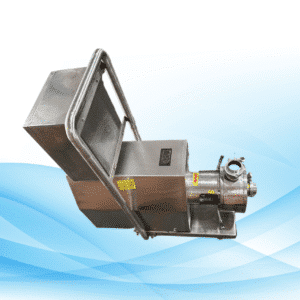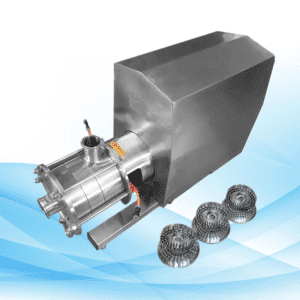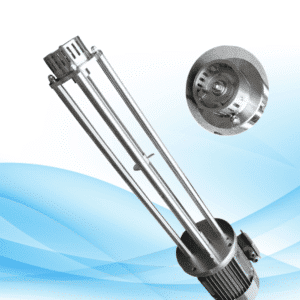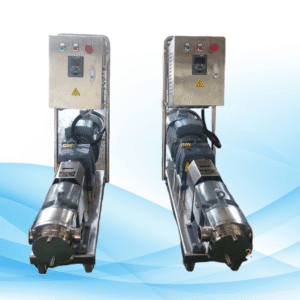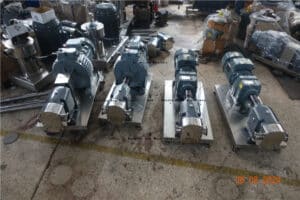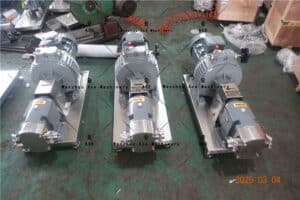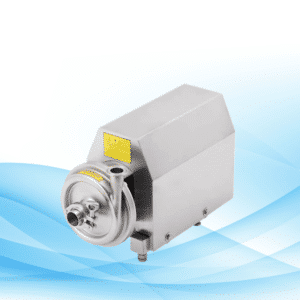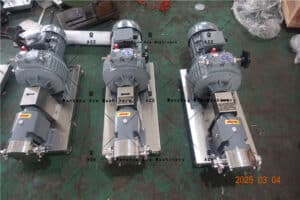For liquid handling in food, beverages, pharmaceuticals, and cosmetics, the transfer process must be accurate and safe. One of the most significant pieces of equipment in this context is the food grade transfer pump. Efficient and hygienic food grade pumps guarantee that oils, juices, syrups, and dairy products remain uncontaminated while being transported. In this guide, we shall dissect the various types of food grade transfer pumps, their features, pros, and selection tips.
What is a Food Grade Transfer Pump?

A food-grade transfer pump is a specialized pump designed to meet the rigorous hygiene and safety standards required in food and beverage processing. Food processing pumps need to be made from food grade materials like stainless steel or plastic to prevent contamination. Food grade pumps are different from industrial pumps because they guarantee that the liquid being transferred does not have contact with harmful substances.
Necessity of Food Grade Transfer Pumps
There is no denying the necessity of food grade transfer pumps. The hygiene standards are very high in industries that deal with liquids to be consumed or used in medical and cosmetic products. Food grade pumps help eliminate these challenges by:
- Stopping contamination from poisonous chemicals or bacteria.
- Helping to meet food regulations.
- Minimizing the chance of contamination between different liquids.
- Improving the efficacy of the transfer process.
Classifications of Food Grade Transfer Pumps
There are different classifications of food grade transfer pumps and they vary with respect to the liquids to be transferred and operational requirements. The following are the most common ones:
1. Centrifugal Food Grade Transfer Pumps
Centrifugal pumps are amongst the well known types of food grade transfer pumps. The centrifugal pump’s primary parts include an impeller which spins, creating centrifugal force to help move liquid through the system. These pumps are common for the transfer of liquids like water, oils, juices and other liquid with low to medium viscosity.
Pros:
- Significantly high flow rates
- Most appropriate use case is for liquids that are of low to medium viscosity.
- Easy to maintain due to comparatively simple design and lower number of moving components.
Best suited for: Thin liquids like water, juices, or oil with low viscosity.
2. Positive Displacement Pumps
Positive displacement pumps are another type of food grade transfer pump. These pumps function by containing a certain volume of liquid which they then forcefully push through the system. They are excellent for use with thicker liquids or for products that require a precise amount of flow like creams, pastes and syrups.
Pros:
- Great for handling liquids with high viscosity.
- Excellent accuracy and consistency of flow.
- Broad product versatility including materials sensitive to shear.
Best suited for: Liquids with high viscosity, like syrup, honey, and cream.
3. Diaphragm Food Grade Transfer Pumps
Diaphragm pumps are a subset of positive displacement pumps. These pumps utilize a diaphragm in order to pump liquids. They are ideal for pumping viscous fluids and fluids with suspended solids including sauces, soups, and purees.
Benefits:
- Solids or particulates can be mixed with liquids and pumped together.
- Able to self-prime and dry run for limited amounts of time.
- Can be used in sanitary applications as it is easy to clean.
Best for: Sauces, soups, pastes, and any products that contain particulates.
4. Food Peristaltic Transfer Pumps
With peristaltic pumps, the fluid is moved using a rotor and flexible tube. The rotor rotates, compressing the tube and pushing the liquid through the pump. These pumps work great with higher viscosity products ensuring minimal damage to them.
Benefits:
- Pumping action that is gentle and reduces degradation of product.
- Works well with products that are sensitive and require minimal shear.
- Reduces amount of time required for cleaning and maintenance.
Best for: Most pharmaceutical products, cosmetics, and any other products that are shear sensitive.
Essential Considerations When Selecting a Food Grade Transfer Pump
Choosing a food grade transfer pump requires you to look at certain features and characteristics that are critical in ensuring proper use. Below are factors that you ought to look into.
1. Selection of Material
Foods Safety Standards require food grade pumps to be constructed of materials that do not corrode or are easy to maintain. The most widely used material for food grade pumps is food-grade stainless steel, particularly grade 316, because it does not corrode, is strong, and is safe for use in kitchens.
2. Design Features
The user should ensure that the design of the pump allows for adequate cleaning to ensure that bacteria or other impurities do not thrive. Hygiene pumps should be smooth and polished and made with minimal joints and crevices that could harbor dirt and make cleaning difficult.
3. Maximum and Minimum Flow Rate and Pressure Level
Use of a pump should also depend on the required flow rate and pressure for the specific process. When selecting a food grade transfer pump, choose a model specific to your process whether It’s a high-flow pump for faster transfer of liquids, or high-pressure pumps for thick liquids.
4. Ease of Maintenance
When selecting a pump, focus on the features that make it easy to take apart, clean, and put back together. Food grade pumps designed for maintenance without tools can improve efficiency by not only saving time, but minimizing operational downtime.
5. Certifications
Confirm that the food grade transfer pump you select complies with key regulations like FDA, NSF, or 3A to protect and guarantee that the pump’s design meets food safety requirements.
Advantages of Using Food Grade Transfer Pumps
1. Enhanced Hygiene
To prevent contamination, food grade pumps are designed to incorporate materials that ensure the hygiene of the liquid being transferrred especially in the food processing or pharmaceutical industries where regulatory issues such as health contamination could become a problem.
2. Improved Efficiency
These pumps are equipped with the latest technology, allowing for enhanced performance when dealing with liquids. Whatever the range of liquid viscosity, using the appropriate food grade transfer pump will facilitate the entire process.
3. Compliance with Regulations
Following industry protocols and guidelines is of utmost importance. Regards to the food grade transfer pumps, these items are designed to fulfill regulations set by authorities like the FDA so as to ensure that your operations are compliant with food safety laws.
4. Cost Savings
The investment in food grade pumps might be disproportionate to non food grade pumps, but the gains in product value, cleanliness and effectiveness over time makes it cost-efficient. Moreover, reduced downtime and repair costs accompany the affordability due to the durability and minimal ongoing maintenance requirements of food grade pumps.
How to Choose the Best Food Grade Transfer Pump
Consider the following factors when selecting a suitable food grade transfer pump for your business:
- Liquid Type: Decide whether you are dealing with clear liquids, products containing viscous liquids, or solids.
- Flow Requirements: Grasp the flow rate that is needed for your application.
- Maintenance: Ensure that the pump suits your maintenance abilities and operational schedules.
- Budget: Food grade pumps will most likely yield a higher initial investment, so make sure that the buy will assist you in achieving your long term operational ambitions.
Everyday Uses of Food Grade Transfer Pumps
These pumps have a place in many industries. Here are some examples:
- Beverage Industry: Moving juices, water, and other soft drinks.
- Dairy Processing: Transferring liquid milk, cream, and yogurt.
- Sauces and Condiments: Pouring thick sauces, ketchup, or mayonnaise.
- Pharmaceuticals and Cosmetics: Moving ingredients for creams, gels, and other sensitive materials.
Frequently Asked Questions (FAQ)
1. Why is it called a “food grade” pump?
Food grade transfer pumps are built with parts that can be washed and are safe to use for food and drink products. These parts are mostly stainless steel, which does not rust or get contaminated.
2. Can I use an ordinary industrial pump to a food processing facility?
No. Industrial pumps do not have the required levels of cleanliness for food processing, as restircted by hygiene regulations. If a food grade pump is applied to food processing type work, it will lead to contamination and compromise the safety of the product.
3. What types of liquids can food grade transfer pumps handle?
Food-grade transfer pumps are specifically designed to handle a wide variety of liquids such as water, oils, juices, sauces and dairy products. The type of pump selected is usually dependent on the viscosity and composition of the liquid in question.
4. How do I maintain my food grade transfer pump?
Pumps specially designed for food require extra attention and meeting maintenance protocols to ensure they are always in good shape. Such tasks like regularly cleaning the pump after every usage, checking for damages, and conducting routine functionality checks should all be normal. Most food grade pumps are easy to clean as they are designed for easy disassembly.
5. Are food grade transfer pumps expensive?
Like any other equipment, food grade transfer pumps will come at a greater price than non food grade pumps. But due to their ever-lasting durability, minimal upkeep and ease-of-use, these food-grade pumps become a useful asset for any food or beverage company.
Conclusion
To sum up, choosing the right food grade transfer pump is crucial for the safety, productivity, and effectiveness of your liquid transfer processes. If the correct pump type is chosen and factors such as the construction material, maintenance needs, and flow requirements are considered, a high degree of hygiene and liquid handling can be maintained. The correct food grade pump can add great value to your operations in the food, beverage, pharmaceutical and cosmetic industries.

